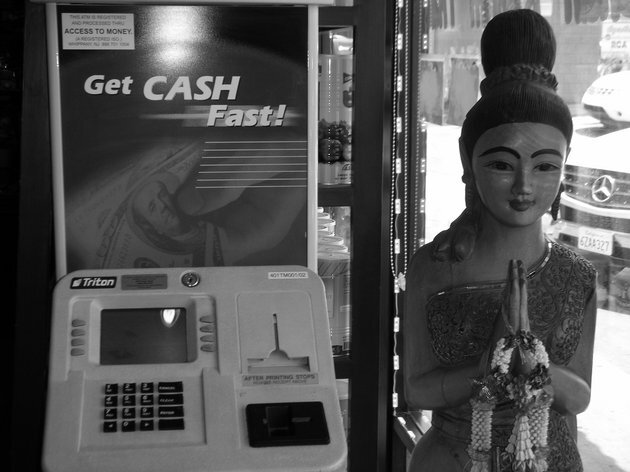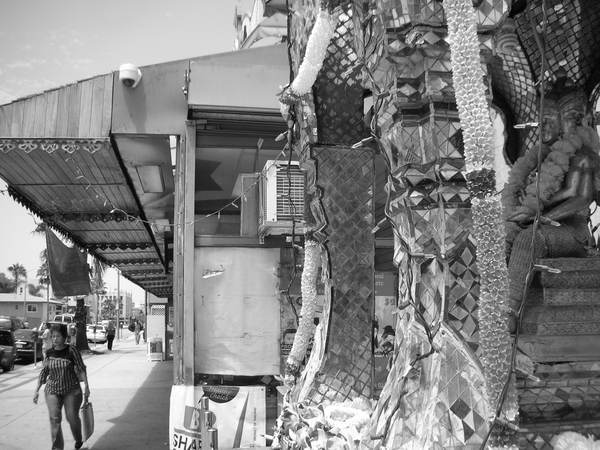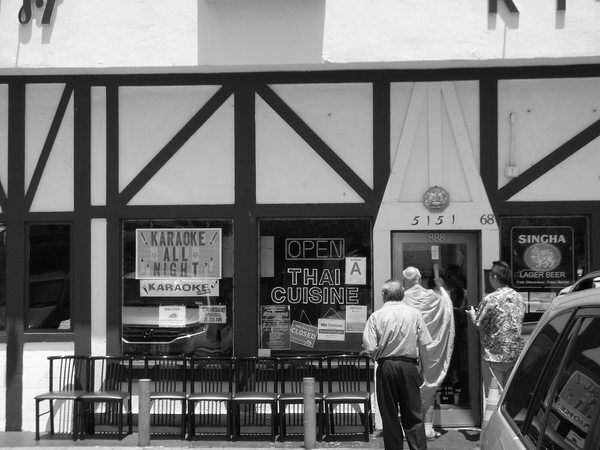A Los Angeles Primer: Thai Town

Heading north on the Red Line one morning, I looked around the crowded car and saw only tourists from abroad. Chinese, many of them huddled together over guidebooks and most wearing bulky, expensively long-lensed cameras around their necks, made for the most visible presence. I also spotted a Francophone family, the father of which flipped through the pages of Lonely Planet's "Ouest américain." Which part of the city had they chosen to explore, I wondered as we passed through Koreatown and Los Feliz, then turned toward Hollywood. None of them got off before I did, at Western Avenue, which led me to suspect the worst: the train would soon disgorge them all onto the Hollywood Walk of Fame. A conversation with some visiting Germans the week before had primed me to make that assumption. When I asked them where the friends and literature they'd consulted suggested they go in Los Angeles, they recalled only a few: the Santa Monica Pier. Universal Citywalk. The Walk of Fame.
They at least came with an advantage over some visitors, who show up secure in their many assurances received that Los Angeles contains, in its nearly 500 square miles, nothing at all, and that they can continue guiltlessly on to San Francisco. Others hear that Los Angeles at least offers Disneyland, a thirty-mile drive out of the city and into another county entirely. But most travelers with a little time on their hands seem to wind up, sooner or later, on Hollywood Boulevard. I don't mean to condemn an entire street, much less one that runs for five miles through several different neighborhoods, but it seems to pull people as if with its own gravitational force into the wrong one, Los Angeles' embarrassing equivalent of Fisherman's Wharf or Times Square. I make an exception for the Egyptian Theatre, whose stream of revival screenings from the American Cinematheque did more than its part to convince me that I could live in no other city in America, but west of Vine Street, Hollywood Boulevard saddens, especially when you consider how many people take it, surely with no small bewilderment, as representative of the entire city.

Any Angeleno insisting that tourists visit the wrong places, of course, faces the burden of identifying the right ones. Attempting that clarifies the problem, which has to do with whichever quality of Los Angeles renders traditional guidebooks, with their focus on specific points of attraction and notions of centrality, not particularly useful. "Where do you go in Los Angeles?" doesn't quite make sense as a question, as didn't a question the Germans asked when we discussed where to go for dinner: "What is typical to eat in Los Angeles?" These allow only the answer that zen koans allow: "mu," a term meaning neither yes nor no that highlights nonsensical premises in the question itself. You don't do anywhere in particular here, nor do we typically eat anything in particular here, yet you can go to a wider variety of places than in other cities, and you can eat a wider variety of foods than in other cities. To the extent that anyone can explain Los Angeles, they do far better with terms of potential than of actuality. Start moving east, away from Hollywood and Highland — far away, preferably — and after a couple miles or as many subway stops, you'll find yourself in a neighborhood that illustrates the right this city grants to cultural and culinary variety: Thai Town.
Occupying Hollywood Boulevard between the Avenues Western and Normandie (though with a more recent creep, in spots, to Sunset Boulevard below), Thai Town provides, most visibly and most accessibly, a great many Thai restaurants. These open gateways for the curious visitor to the smaller Thai coffee shops and dessert dealers, the Thai book and video stores, the Thai massage parlors. While you wouldn't mistake a walk down this stretch of Hollywood, past a scattering of Armenian businesses, an abundance of slowly crumbling midcentury motels, and Jumbo's Clown Room, for a walk in Bangkok, the full name of Thailand's capital, like that of Los Angeles, also calls it a city of angels, and that sets the mind looking for other urban resonances. Bangkok has gained, and even cultivated, a reputation as a place where one's every impulse, up and down the spectrum of savoriness, can find satisfaction at any time of day or night. Whichever impulses one can satisfy in Los Angeles, one usually has to satisfy them between the hours of 9:00 a.m. and 10:00 p.m. Does Bangkok really operate as one enormous den of vice, and does the whole of Los Angeles really shutter during television prime-time? Clearly not. But the smoke of a place's reputation never spreads without some kind of fire.

Thai Town, that seed of Bangkok planted in the vast American field of Los Angeles, has thus grown into something of a refuge for late-nighters. I myself take comfort in the knowledge that, should the rare bout of hunger strike after 10:00 p.m. that the Korean food in my neighborhood can't satiate, Thai Town lays only a few minutes' ride away. There I'll find purveyors of larb, papaya salad, tom kha soup, and crispy pork neck open until 2:00 a.m., 3:00 a.m. — open even, unbelievable as it may sound, all night long. (That last, however, will remain more a theoretical advantage than a practical one until the subway runs 24 hours as well, though if you miss the last train of the night, consider indulging in a four- or five-hour Thai meal while you wait. Do pace yourself.) The most enjoyable of these after-Angeleno-hours eateries will spare every expense in their decor, yet also seize every opportunity to use objects — any objects — to generate visual interest. I follow the beacon emanating out of a restaurant's window when it comes from lights originally manufactured for Christmas trees. These places stand well apart from the great wave of Thai food that has washed over the United States for the past twenty years, turning ever blander and more homogenous as it spreads.
So find the right Thai Town spot, with the right ramshackle-yet-cheerful aesthetic, at the right hour, ordering the right degree of spiciness, and you'll feel, if only for a moment, like a character in an Apichatpong Weerasethakul movie. If you've followed the career of Thailand's most critically acclaimed living auteur, you'll know that his characters go back and forth between the city and the country, the urban and the rural, the built environment and the natural one, but revel in the latter. If you, too, seek nature's solace — and after enough fermented pork sausage, you may well need it — it lays closer at hand in Los Angeles than it might in Bangkok, where, judging by Weerasethakul's work, you'd need to make a lengthy journey into the provinces. Not that I'd recommend Thai Town to tourists, Chinese, French, German, or otherwise, as an alternative to a trip to Thailand itself. But I would recommend it — and, more to the point, the walk into it, the passage through it, the experience of its margins where one culture gives way to another, and the return to it when much of the rest of the city has gone to bed — as an alternative to staring down into the pavement at the names of David O. Selznick, and Barry Manilow, and Shrek. Still, the Walk of Fame has its uses, and I'll pay it a visit soon as my favorite Thai director gets a star on it. Assuming one can fit his name.
Photos by Colin Marshall.